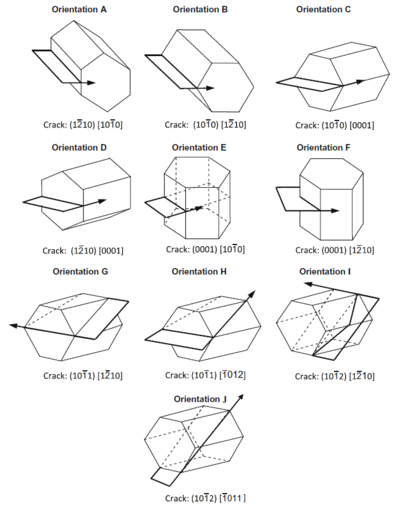Integrated Computational Materials Engineering (ICME)
MD Fatigue Crack Growth
Abstract
The fatigue crack propagation behavior of magnesium single crystal was analyzed using molecular dynamics simulation[1]. The interatomic potential used in this investigation is Embedded Atom Method (EAM) potentials. The studies of the mechanism of fatigue crack growth in different crystal orientation were performed using Center Crack (CC) specimens while Edge Crack (EC) specimens were employed to investigate the effects of strain rate and temperature. For CC specimen, the periodic boundary conditions were assigned in the x and z direction, while for EC specimen, only z direction was allowed periodic boundary conditions. In order to study the orientation dependence of fatigue crack growth mechanism, 10 crystal orientations of initial crack were analyzed and the simulation results reveal that the fatigue crack growth rate and the crack path vary significantly with the crystallographic orientations of initial crack. The growth rate of orientation D is the highest and the resistance of fatigue crack growth of orientation B is the highest. The analysis of the influences of strain rate was carried out on the orientation F and the results revealed that the growth rate of fatigue crack decreasing with increasing strain rate. The fatigue crack growth rates of different orientation decrease with increasing temperature.
Author(s): Tian Tang, Sungho Kim, Mark F. Horstemeyer
Corresponding Author: Sungho Kim

Methodology
To study crystal orientation effects, 10 different crystal orientations of initial crack, namely, orientation A-(1 -2 1 0)[1 0 -1 0], orientation B-(10 -1 0)[1 -2 10], orientation C-(1 0 -1 0)[0 0 0 1], orientation D-(1 -2 1 0)[0 0 0 1], orientation E-(0 0 0 1)[1 0 -1 0], orientation F-(0 0 0 1)[1 -2 1 0], orientation G-(1 0 -1 1)[-1 0 1 2], orientation H-(1 0 -2 1)[1 -2 1 0], orientation I- (1 0 -1 2)[1 0 -1 1], and orientation J-(1 0 -1 2)[1 -2 1 0], were considered as shown in figure 1.

Figure 1. Crystal orientations. (click on the image to enlarge).
Material Model
Large-scale Atomic/Molecular Massively Parallel Simulator (LAMMPS)
Input Data
See LAMMPS Input Deck for MD Fatigue Crack Growth
Results
The following major conclusions were drawn from our simulations:
- The mechanism of fatigue crack propagation is strongly dependent on the crystal orientation of the initial crack.
- The resistance of fatigue crack growth of orientation B is the highest while the crack growth rate of orientation D is the highest.
- The dislocation emissions and twin bands occurring at the crack tips due to the stress concentration play major roles on the mechanism of fatigue crack growth. The plastic deformation at the crack tip has dual effects on the fatigue crack growth. It can either enhance the fatigue crack growth or increase the resistance to fatigue crack growth.
- The growth rate of fatigue crack growth decreased with increasing strain rate at the nanoscale.
- The mechanism of fatigue crack growth in the orientation A was strongly affected by the temperature, while the temperature does not have significant influences on the mechanism of fatigue crack extension of other orientations. However, the growth rate decreases with increasing temperature in all orientations except orientation A, B, and E.
Acknowledgments
The authors would like to acknowledge DOE and CAVS at Mississippi State University funding for this work.
References
- ↑ Tang, T., Kim, S., & Horstemeyer, M. (2010). Fatigue Crack Growth in Magnesium Single Crystals under Cyclic Loading: Molecular Dynamics Simulation. Computational Materials Science, 48, 426., 48, 426-439 (http://dx.doi.org/10.1080/14786430701255895).
